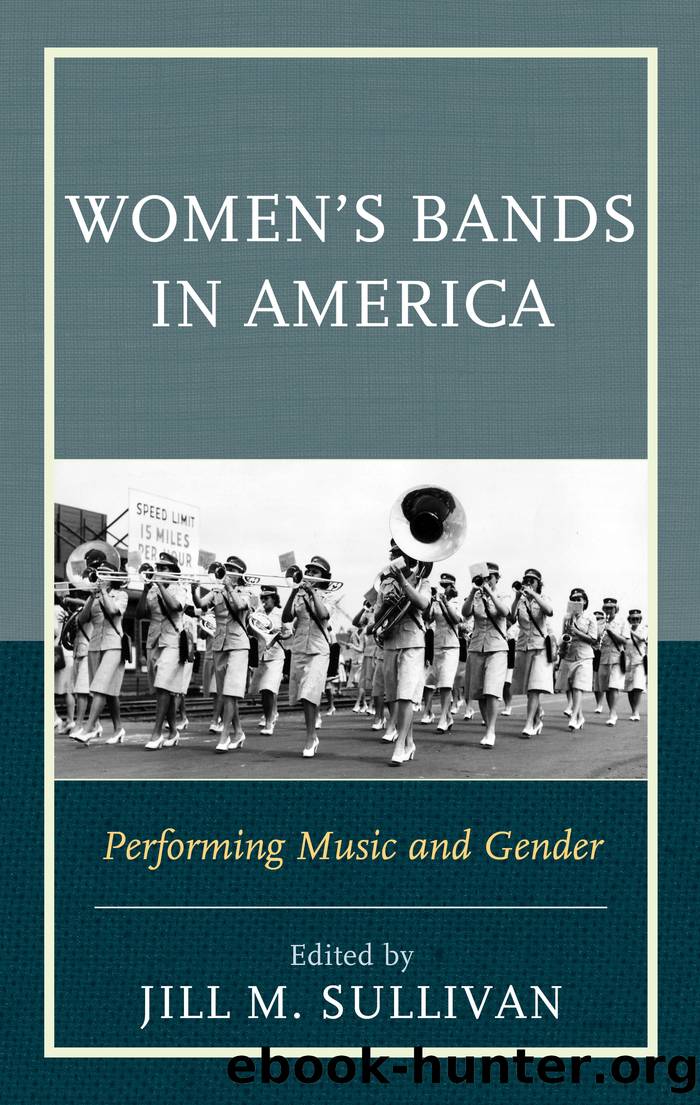Women's Bands in America by Sullivan Jill M.;

Author:Sullivan, Jill M.;
Language: eng
Format: epub
Tags: undefined
Publisher: Rowman & Littlefield Unlimited Model
Published: 2012-09-15T00:00:00+00:00
A Star on the Horizon
The Girl Stars project could not have come at a better time. Williams was at the peak of her popularity, enjoying success in three major areas: recording, performance, and large-scale jazz composition. The decade had begun with Williams waxing several sides for a major record labelâDecca. She had been able to continue recording in the ensuing years (military-only V-Discs notwithstanding), albeit with Aschâs independent label. After false starts leading a combo while based in Pittsburgh and first coming to Manhattan, her career as a nightclub and stage performer was now on secure footing. Though her relationship with him was complex, she had landed management and representation by one of the entertainment industryâs most powerful figures, Joe Glaser. She had secured a major engagement at New Yorkâs trendiest nightclubs, Café Society Uptown and Downtown, and other out-of-town clubs. By the mid-1940s Williams had become a regular fixture in New York jazz.
Williams was expanding beyond nightclub performance as well, first by venturing into other sectors of the entertainment industry. Her friendship with Café Society owner Barney Josephson led to her hosting a successful radio show Sunday afternoons on New Yorkâs WNEW (CBS) in 1945, the âMary Lou Williams Piano Workshop.â Commonly acknowledged as the place where she began her Zodiac Suite, Williamsâs radio show also marked another milestone, both for Williams personally and as a Race Woman: she was one of few African Americans hosting his or her own regular radio broadcasts in the decades (1920sâ1940s) after the birth of network radio and prior to the debut of African Americanâoriented programming on the pioneer Memphis station, WDIA in 1948âthe years during which radio was a live medium.[55] Tapping another market, Williams had contracts with Robbins Music Corporation to publish sheet music of her most successful boogie-woogie compositions.[56]
Williams also explored stage and film. She was poised for Broadway success as both performer and composer, appearing in the revue Blue Holiday (intended as a comeback vehicle for Ethel Waters) and having written the score for Herman Shumlinâs production of Robert Ardreyâs drama about Southern racism, Jeb (with Ossie Davis in his first Broadway lead role). Unfortunately, neither production was successful. Blue Holiday opened May 21, 1945; it closed after a week. Jeb, which opened February 20, 1946, closed after only nine performances. She is known to have done at least one film. The trade publication Variety lists her appearance in the 1947 Herald Pictures race film Boy! What a Girl (Arthur Leonard, director).[57]
Beyond being active in live performance, sound recording, print music, and radio broadcasting, Williams was effectively navigating a shift from popular and vernacular entertainments to âhigh culture.â With her reputation growing beyond the jazz nightclub and jam session scene, she built on her success as a solo pianist by garnering further acclaim as she began to move between the nightclub and the concert world as both performer and composer. The month before the second Girl Stars session, Williams had been the featured performer in pops concerts at Carnegie
Download
This site does not store any files on its server. We only index and link to content provided by other sites. Please contact the content providers to delete copyright contents if any and email us, we'll remove relevant links or contents immediately.
Aircraft Design of WWII: A Sketchbook by Lockheed Aircraft Corporation(32143)
The Great Music City by Andrea Baker(30929)
Call Me by Your Name by André Aciman(19960)
The Art of Boudoir Photography: How to Create Stunning Photographs of Women by Christa Meola(18421)
The Secret History by Donna Tartt(18266)
Shoot Sexy by Ryan Armbrust(17568)
Plagued by Fire by Paul Hendrickson(17125)
Portrait Mastery in Black & White: Learn the Signature Style of a Legendary Photographer by Tim Kelly(16880)
Adobe Camera Raw For Digital Photographers Only by Rob Sheppard(16808)
Photographically Speaking: A Deeper Look at Creating Stronger Images (Eva Spring's Library) by David duChemin(16511)
Ready Player One by Cline Ernest(14061)
Pimp by Iceberg Slim(13828)
Bombshells: Glamour Girls of a Lifetime by Sullivan Steve(13718)
The Goal (Off-Campus #4) by Elle Kennedy(13222)
Art Nude Photography Explained: How to Photograph and Understand Great Art Nude Images by Simon Walden(12860)
Kathy Andrews Collection by Kathy Andrews(11361)
The Priory of the Orange Tree by Samantha Shannon(8652)
Thirteen Reasons Why by Jay Asher(8490)
The remains of the day by Kazuo Ishiguro(8429)
